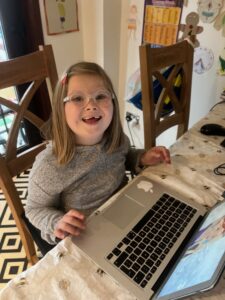Understanding Down Syndrome: Facts, Realities and Breaking Stereotypes
I was 16 weeks pregnant when my daughter Mia was diagnosed with Down Syndrome (DS), and I’ll be honest, it came as a big, scary shock. My partner and I didn’t know how to take this news, as, at that time, we knew so little about the condition.
We were so worried and had a ton of questions for our consultant – what did this mean? Would our daughter have major health complications? How severe would her learning disability be? Would she be able to hold down a job when she was older? A million questions flew through our minds.
There were so many myths and stereotypes to wade through to get to the facts. Thankfully we received support from charities like Down’s Syndrome Scotland, and were able to learn about the condition, and meet other families with experience and knowledge of what it would mean to have a child with DS.
6 years later and Mia is absolutely thriving. She is a formidable force filled with determination, love and mischief! Whilst it may take her a bit longer to learn things than the average typically developing child, with the right support at school, she is able to keep up with her peers and very much enjoys learning.

Thankfully we live in an age where people with Down Syndrome are no longer hidden and have a much bigger share of voice in the communities they live in than they did even 20 years ago. At Hillcrest, some of our Futures Services provide care to people with Down Syndrome, and our Support Workers help them to live their lives as independently as possible.
October is Down Syndrome Awareness Month, and a great opportunity to share information about the condition.
What Is Down Syndrome?
Down Syndrome is a genetic condition that occurs when a person has an extra copy of chromosome 21. This additional genetic material affects development and can lead to physical and intellectual differences. It’s one of the most common chromosomal conditions, occurring in about 1 in every 700 births worldwide.
There are three types of Down Syndrome:
Trisomy 21 (most common): every cell has an extra chromosome 21.
Translocation: part of chromosome 21 attaches to another chromosome.
Mosaicism: only some cells have the extra chromosome.
Who Does It Affect?
Down Syndrome affects people of all races, nationalities, and socioeconomic backgrounds. It’s not caused by anything parents do or don’t do – though maternal age can slightly increase the likelihood; it can happen to anyone.
People with Down Syndrome are individuals first. They have unique personalities, talents, and interests, just like anyone else.
What Does It Mean to Have Down Syndrome?
Having Down Syndrome means living with certain physical traits (such as almond-shaped eyes or low muscle tone), and varying degrees of intellectual disability. But it also means:
- Learning and growing – often at a different pace, but with the same potential for joy, achievement, and connection.
- Participating in society – many people with Down Syndrome attend school, hold jobs, form relationships, and contribute meaningfully to their communities.
- Living full lives – with access to healthcare, education, and support, individuals with Down Syndrome can thrive, just like Mia!
Common Stereotypes – and Why They’re Wrong
|
Stereotype |
Why It’s Wrong |
|---|---|
|
“People with Down Syndrome are always happy.” |
People with Down Syndrome experience the full range of emotions – just like everyone else. |
|
“They can’t learn or work.” |
Many individuals with Down Syndrome graduate from school, university, hold jobs, and live independently or semi-independently. |
|
“They all look the same.” |
While some physical traits are common, every person with Down Syndrome is unique in appearance and personality. |
|
“They’re a burden.” |
This harmful myth ignores the love, joy, and value people with Down Syndrome bring to families and communities. |
Moving Forward with Respect and Inclusion
Understanding Down Syndrome means seeing beyond the diagnosis. It means recognising ability, not just disability. It means listening to voices from people within the Down Syndrome community, advocating for inclusion, and celebrating diversity.
For any Strictly Come Dancing fans out there, you’ll appreciate that having Down Syndrome doesn’t necessarily stop people from following their dreams! Ellie Goldstein, who has Down Syndrome and is participating in this year’s series, is an absolute star and is proudly helping to break down stereotypes and outdated judgements about what it means to live with the condition. Go Ellie!
Let’s replace stereotypes with stories – real ones, full of understanding, learning, and love.
Stay tuned for more stories from some of our services who support people with Down Syndrome, which we look forwards to sharing over the coming month.